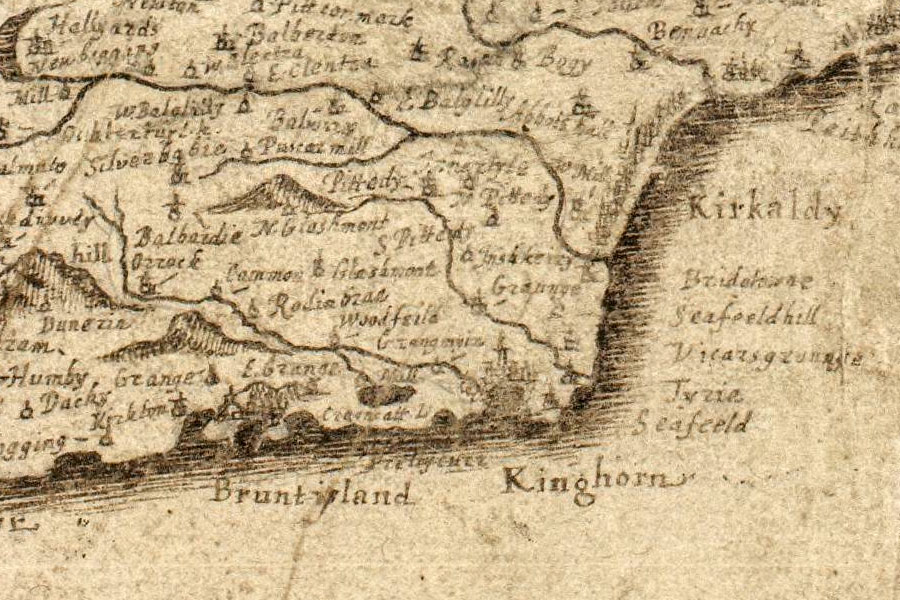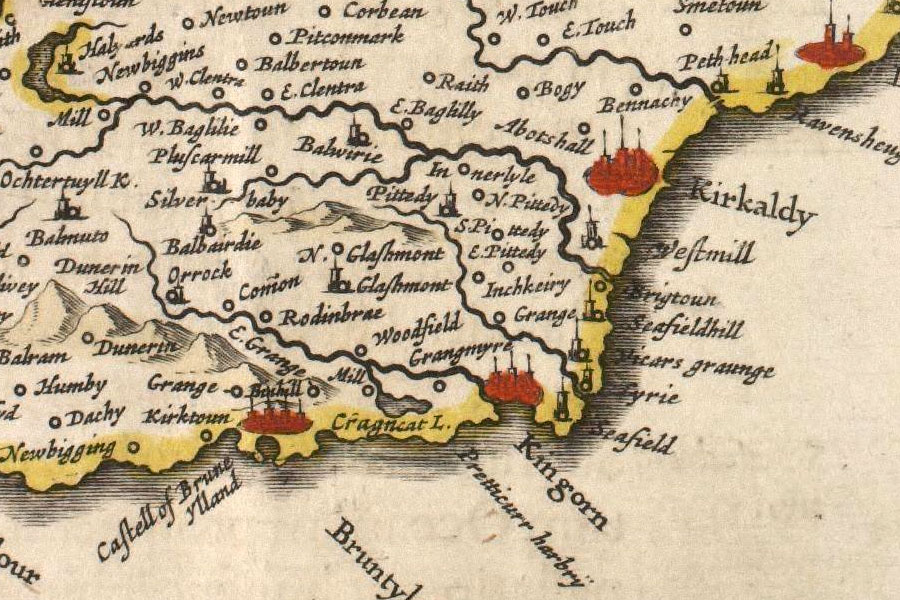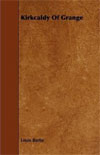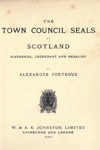

A castle named Glamis Tower once stood on this site, now a residential street at the north end of Kinghorn, but nothing of it now remains.
It should be mentioned at this point that the early history of this castle seems to have become confused in antiquity. Several writers have repeated parts of a history that actually seems to belong to the Glamis Castle in Angus.
There is of course the possibility that these histories have been wrongly applied to the Angus castle, and do in fact refer to this castle in Fife, but at this stage it isn’t completely clear to me which is which.
The story goes that the original castle, variously known as Glamis Tower, Glammis Tower, or Kinghorn Tower, was a royal castle dating back to at least the reign of William the Lion (making it probably 12th century or earlier in date).
It is said that when Sir John Lyon married Robert II’s daughter Jean Stewart in 1373, the King granted the castle to Sir John as part of the dowry. However this is also said of Glamis Castle in Angus, and there was an earlier castle in Kinghorn, known as Kinghorn Castle, and probably located some 800 metres to the south at Pettycur.
Interestingly though, in The Town Council Seals of Scotland the dowry is described as including “the Castle and Barony of Kinghorn” rather than referring to it as Glamis Tower as in other sources, although the author doesn’t note his source for this.
In 1463 Alexander Lyon, the 2nd Lord Glamis, was granted a charter of the Castle of Kinghorn and the lands of Balbardie from Mary of Guelders, the mother of James III who was ruling as Regent at that time. If it is accepted that Jean Stewart’s dowry included the Glamis Castle in Angus, then it seems likely that the 15th century is when Kinghorn Castle came into the Lyon family.
John Lyon, the 7th Lord Glamis, forfeited the lands and barony of Kinghorn in 1537 and they were granted by James V to James Kirkcaldy of Grange. However following the death of James V in 1542, John Lyon was restored to his lands and titles in 1543.
One history has it that Glamis Tower was rebuilt, or possibly built, in 1542 or 1543, which certainly ties in with this significant moment in its history. However it is still being referred to as the “castle of Kinghorn” at this time rather than as Glamis Tower, and it isn’t clear if this is the castle to the north of Kinghorn, or that to the south at Pettycur.
Whichever castle is being referred to, in 1546 it was besieged by Sir James Kirkcaldy of Grange, and seized by him.
The first mention I can find of Glamis Tower under that name comes from 1559, when a French army was attacking Protestant targets in Fife during the Reformation, although it was written in 1849:
The moment he saw Kirkaldy’s horsemen in their shining jacks appear, l’Abast, like a skilful soldier, threw his company into the ruined and decayed village of Glameshouse, situated among the steep and arid rocks, broomy hills, and sandy scaurs near the picturesque old burgh of Kinghorn, which had then the venerable tower of St Leonard crowning its scattered lines of steep and straggling alleys. L’Abast posted some of his soldiers in the ruins of the village; others occupied the place of Glames, with its court and yards
Memoirs and Adventures of Sir William Kirkaldy
James Grant, Edinburgh, 1849
A second account of the same attack, written in 1877, has a different spelling of the house name:
He and Kirkaldy besieged and took an old ruin called Glennis House, which a French officer, of the name of La Bastie, has fortified.
The Scottish Nation, Volume 2
William Anderson, Edinburgh, 1877
Glennis House is also mentioned in an account from 1897:
The French beat a hasty retreat as far as Glennis House, into which they threw themselves. Whilst some occupied the mansion, others took up their position within the courtyard.
Kirkcaldy of Grange
Louis Barbé, New York, 1897
It appears again in an account written by John Knox in the 16th century, and edited for publication in 1899:
….till they had them more than a mile from Kinghorn, and then began the horsemen to break. This perceived, the French altogether drew to a place called Glennis House, and made for debate; some took the house, and others defended the close and yard.
The History of the Reformation of Religion within the Realm of Scotland
John Knox, London, 1899
It seems likely to me that the “place of Glames” and “Glennis House” could be Glamis Tower. However, the castle of Kinghorn is again mentioned in 1564, when it was in the possession of Sir William Kirkcaldy of Grange, the son of Sir James.
Sir William Kirkcaldy was hanged in 1573 for his part in holding Edinburgh Castle for Mary Queen of Scots, and the Grange estates were distributed to others, with the castle of Kinghorn being given to Sir Robert Melville of Murdocairnie, the son-in-law of Sir William. However in 1581 James VI returned the Kirkcaldy of Grange‘s estates to them.
Interestingly, one of Sir William’s grandsons, William Kerr (who later took the name Kirkcaldy when he succeeded to the Grange estates), married Elizabeth Lyon, daughter of John Lyon, the 8th Lord Glamis, in 1586 or 1587.
In 1606 Patrick Lyon, the 9th Lord Glamis, was created the Earl of Kinghorn (or Kinghorne), although this doesn’t appear to have included the castle, as a charter of 1631 confirms that Sir William Kirkcaldy’s son, Robert Kirkcaldy of Grange, possessed the castle of Kinghorn at that time.
In 1649 Sir John Scot of Scotstarvit bought some of the lands at Kinghorn that had been granted to Lord Glamis, and it may be that he also bought the castle.
Beyond the 17th century little seems to be written about the castle here, but it is said to have largely been demolished around 1790.
Writing in the Ordnance Gazetteer of Scotland in the late 19th century, Francis Groome describes the site of the castle as being within a field, with nothing of it remaining. However it was apparently still possible to see some traces of the foundations in 1906.
Given the lack of evidence relating to a castle named Glamis Tower in Kinghorn – it doesn’t appear on early maps as one might expect, and there are few references to it in the usual documentary sources – it’s tempting to speculate that over the years there has been some confusion between the Glamis and Kinghorn names.
Kinghorn is marked on early 17th century maps, with a tower representing what is likely to be a castle. However the maps aren’t clear enough to establish the exact location of the castle, it could be either on this site, or down at Pettycur.

Blaeu Atlas of Scotland, 1654
I believe the most likely explanation is that this castle replaced the earlier Kinghorn Castle, possibly in the 16th century, but was also known as Kinghorn Castle throughout the following centuries.
The name Glamis Tower may have become applied to the castle, possibly after it had fallen into disrepair, through the association with the title Lord Glamis.
The site is now occupied by modern housing (numbers 3 to 5 Burt Avenue). The surrounding streets hold several clues, with Glamis Terrace to the north, Glamis Road to the east, Castlehill Walk and Castle Mount to the south, and Castle Wynd to the west.
Alternative names for Glamis Tower
Glames; Glamis Castle; Glammis Castle; Glammis Tower; Kinghorn Tower


















